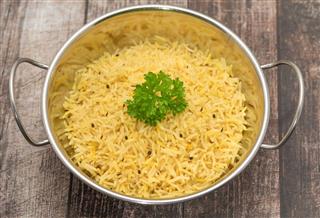
Arborio rice is popularly used to make the Italian risotto. However, if this rice is not available, you can still make your favorite risotto by using arborio rice alternatives, some of which have been discussed here.
Did you know?
Arborio Rice is named after a town in northwest Italy where it was first grown.
Arborio rice, a starchy short-grain rice, is the classic choice for risotto. Risotto is a north Italian rice dish which has a characteristic creamy consistency. This soft creamy texture is due to the high amylopectin (starch) content of arborio rice. The grains are oval in shape and the rice is available in two colors: white and brown. White rice is more starchy than its brown counterpart. Hence it is widely used for making risottos and rice puddings.
Arborio rice is not easily available everywhere. Also, it is more expensive as compared to other varieties of rice. Therefore, substituting this rice with other ingredients is a wiser option. The most suitable substitutes are ingredients having a good amount of starch. Although less starchy ingredients can also be used, you will need to add cream or cornstarch to bring a creamy texture to your recipe.
And now for the substitutes. Basmati rice, Carnaroli rice, or sushi rice can be used as alternatives for arborio rice. You could also use burglar wheat or pearled barley. Here is a list of 9 arborio rice substitutes with reasons why they prove to be good alternatives, and how to use them.
Arborio Rice Alternatives
Pearled Barley
Pearled barley is the best arborio rice substitute of all other types of barley since it has the highest starch content. It gets cooked faster since the bran is partially removed before the grain is polished. Therefore, it does not need to be soaked before cooking, thereby saving the preparation time.
Basmati Rice
Basmati is a type of long-grain rice from India. Being gluten-free, basmati is not the perfect choice for risotto. However, it is a healthy substitute for arborio rice since it has a low glycemic index. For making risotto with this rice, add pumpkin broth to make it sticky.
Brown rice
Although brown rice doesn’t taste as good, it is nutritionally superior to white rice. The milling of brown rice removes only the outermost layer, the hull of the rice kernel. This ensures that the bran is retained, which is high in fiber and nutritional value. Therefore, it is the best choice for people who wish to stay away from simple carbohydrates with zero nutrition value.
Carnaroli Rice
Similar to arborio rice, Carnaroli rice is cultivated in the Piedmont and Lombardy regions of northwest Italy. It is a short-grain rice having high amylopectin content. It cooks to a creamy texture with a firm body and improves the flavor of the dish. Therefore, it is considered as one of the best rices to use in risotto and is popularly known as “the caviar of rice”.
Farro
The term ‘farro’ refers to three ancient wheat varieties first cultivated in the Fertile Crescent and still grown in Italy namely, farro piccolo (einkorn), farro medio (emmer), and farro grande (spelt). The ’emmer’ variety is commonly available in the United States. It can cook very fast in about 25 minutes without soaking.
Sushi Rice
It is a short-grain rice from Japan. It is commonly used for making sushi since it gets slightly sticky when cooked. Similar to arborio rice, this Japanese rice provides the required creaminess to your recipe. Therefore, it does not require additives such as cornstarch or cream.
Quinoa
Quinoa is a high-protein grain cultivated by Incan tribes in the Andes Mountains of South America. It not only has more protein than any other grain, but also contains all 8 essential amino acids. Although quinoa lacks the starchiness of arborio rice, it can still be used as its substitute because of its comparatively high nutritional value. So, to achieve a creamy consistency, add cream or milk to the traditional risotto recipe.
Bulgur Wheat
It is popularly known as cracked wheat in the United States. Basically, it is cracked whole wheat grain, which is made by par-boiling, drying, and then coarsely grinding wheat berries. As a result, it cooks very quickly when steamed or boiled. Bulgur wheat, also known as burghul wheat, is rich in protein and minerals, and has a nutty taste. This high-fiber, low-fat, and zero-cholesterol nutritious grain is another healthy alternative to arborio rice.
Israeli Couscous
Also known as pearl couscous, it is a small, round, pasta-like granule made from semolina and wheat flour. Though not gluten-free, it has a slightly nutty flavor and chewy texture. It absorbs flavor beautifully and takes about 10 minutes to cook in boiling water. Therefore, it is a good alternative for arborio rice and can be used in many different types of dishes, both hot and cold.
Try making risotto using any of the aforementioned arborio rice substitutes, and enjoy different flavors of the same dish.






















